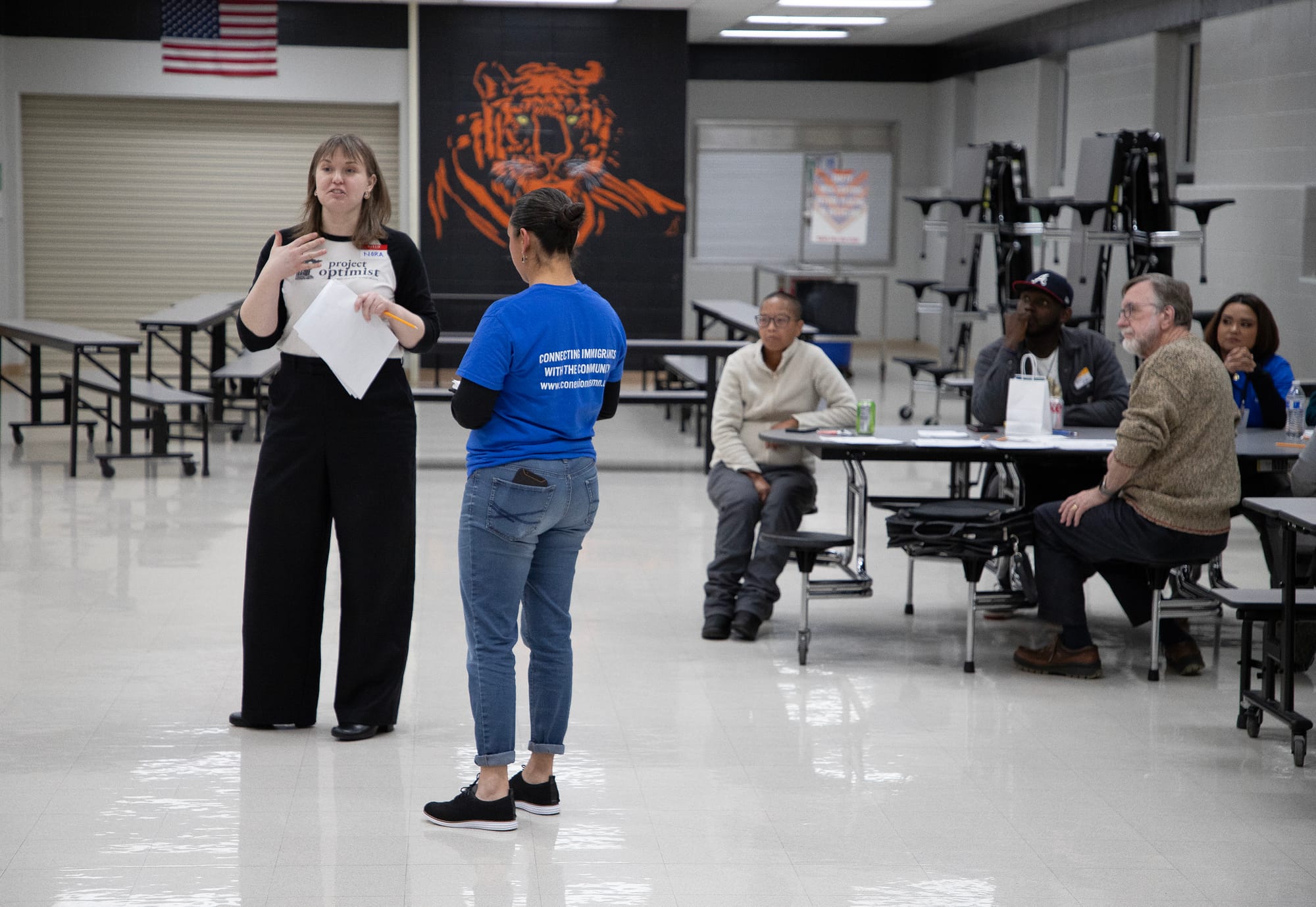After school shooting, former greater Minnesota principal creates HuddLUp to help emotionally isolated kids
HuddLUp, created by a former principal in Cold Spring, Minn., focuses on building connections among students through play.

Jerry Sparby wants to use play to address the mental health crisis in the nation’s classrooms.
In 2003, he was principal of Cold Spring Elementary School when freshman John Jason McLaughlin shot and killed two of his classmates at the adjoining ROCORI High School. This traumatic experience inspired Sparby to go back to school for a counseling degree so he could help all children, especially those who seemed detached or “invisible,” build healthy friendships.
Sparby knew McLaughlin when he was in elementary school. He was, he said, “a perfect student. He was compliant, he always did what the teacher told him to do.” But he struggled to make connections with other students.
“He didn’t know how to make friends,” Sparby said of McLaughlin. “He was fine as long as he was in school. When he was on the playground he was a fish out of water.” After the shooting, Sparby visited McLaughlin in a detention center, where he is serving a life sentence. The lifelong educator wanted to know if there was anything he could’ve done to avert the tragedy.
“I said,” Sparby recalled, “‘I never saw you alone on the playground.’ He said, ‘Mr. Sparby, I was hiding. I didn’t want anyone to know I didn’t have any friends.’”
This conversation inspired Sparby to reach out to kids like McLaughlin, to help children and adults to communicate and connect with one another in more inclusive ways. Sparby knew invisible kids when he worked as a principal; later, in his therapy practice, he met even more. He came to understand that when children feel disconnected from their community, it can have a negative impact on their mental health, and if that disconnection intensifies over a number of years, it can bleed out in dangerous ways.
“Every kid I see for depression, anxiety, they are really the invisible kids in the classroom,” Sparby said. “I’ve been to schools all over the country. Everywhere I went, there were three or four kids who were invisible. I realized if we really want to address this problem we have to figure out how you make sure there are no more invisible kids.”
One approach that Sparby found effective for building connection was through play. Rather than requiring students to sit still and listen to their teachers talk about collaboration and connection, he figured it would be more effective to have children engaged in physical activities that modeled those ideals.
After the pandemic disrupted education worldwide, Sparby saw the number of invisible children in classrooms grow. Pre-COVID, he said he’d see a handful of children struggling, but then, he explained, “After COVID, those three or four turned to seven or eight, especially as you were getting closer to adolescence. The more and more that social anxiety pushed them into their chairs, they didn’t reach out to the kids around them to be friends.”
More than ever, Sparby wanted to get young people moving and connected to each other through play. So he developed HuddLUp, a program where trained instructors come into classrooms and lead students and teachers through a series of breathing exercises and non-competitive games focused on cooperation, connection-building and other positive behavioral traits like honesty and partnership.
This type of instructive play, Sparby believes, is critical to healthy social-emotional learning (SEL), something that many schools have recently brought into focus.
“Our ability to be social with each other is one of those critical stages in development,” he said. “What I keep telling teachers is, ‘You have to have time for those kids to play with each other if you want them to build relationships and truly become part of a community.”
Building connection through play
Now in its second year, the HuddLUp program is based in schools in and around St. Cloud. The free, grant-funded program provides HuddLUp trainers who come into classrooms once a week and lead students in a set of centering rhythmic and breathing exercises before teaching them a new set of collaborative games.
Jim Meyer, HuddLUp program director/mentor, has known Sparby since he was principal at Cold Spring Elementary. He joined his friend and colleague at HuddLUp after retiring from teaching.
Meyer explained that he visits several classrooms a day during the school year.
“We go in for about a half hour,” Meyer said. “Within that half hour we’d do some synchronizing and rhythms with kids, get everybody to do the same thing. A lot of time it was done without telling them, ‘I am going to clap and you have to clap with me.’ It’s about them sensing and feeling and being locked in and paying attention to them.”
More coverage of firearms:

The goal of the HuddLUp games is, Meyer explained, “having fun and making sure everyone is connected. Our games are not about winners or losers. They’re about cooperating with others and having a lot of different partners in a class putting together a classroom challenge.” The hope is that the connections built during the games will extend into the rest of the school day: “It is about getting kids to connect when they are playing and forget about who is in and who isn’t.”
The breathing exercises are almost as important as the games, Meyer said. Because children struggling with mental illness like depression and anxiety are often shallow breathers, he and other HuddLUp staff, “Spend time working on breathing and making kids aware of how they are breathing. We want them to breathe deeply and really fill their lungs. We want to get them to be nose breathers, rather than mouth breathers.”
To make it easier for teachers to use the games on their own, Sparby and his colleagues created the HuddLUp app, a digital library with categorized lists of games and video instructions for play. The first year, an annual subscription cost $50, but that cost proved to be prohibitive on a teacher’s salary. This year, donor funding brought the annual cost down to $4.99.
The design is to make HuddLUp games a regular and popular activity in classrooms, Sparby said. “Our hope is kids will say, ‘Can we do HuddLUp today?’ We’re asking every teacher that signs up for our visits to commit to playing twice a day.”
While making time to play games twice a day could seem like a big disruption in the classroom schedule, Meyer said the emotional connections that the games forge among students can actually make the rest of the school day move more smoothly. “When you have kids who are not feeling connected to others not dealing with their emotions, it can be very disruptive in a classroom,” he said. “HuddLUp is about making the classroom more productive and efficient during that work time as well.”
HuddLUp is intentionally focused on elementary-aged kids. By working with younger children, Sparby said, “We’re being proactive. We are giving kids tools before they are 10 and 12 years old for how to reduce that social awkwardness. That’s the big piece. I believe 90% of the people in prison today were socially awkward or were kids that were the outsiders.”
He thinks the skills taught in HuddLUp games last a lifetime. By demonstrating and learning how all people can work together toward a common goal, how everyone’s contribution is important, Sparby believes he can get all kids — even the “invisible” ones — moving in a more healthy direction.
Kids in HuddLUp classrooms report having friends on the playground, Sparby said. “We allowed them to be together for five minutes, to smile. The games we do are non-competitive. It’s about, ‘How do we win as a class? How do we help each other?’”
HuddLUp in the classroom
Last year, HuddLUp visited between 80 to 90 classrooms in the greater St. Cloud area. Christy Voegele, a teacher in Sartell, had HuddLUp visit once a week to work with her third graders.
“I think students of that age need more time working in relationships and building the social skills and learning how to work with each other,” she said. “Kids right now have a lot of anxiety. With Huddlup there is also a breathing activity that teaches kids how to calm their bodies in a healthy way.”
During the weekly visits, students would practice breathing techniques and learn new games. She added quick versions of the games to the regular school day. It wasn’t long before she saw a benefit among her students.
“Their interpersonal skills and their people skills were getting better,” Voegele said. “Their confidence was increasing and their self-awareness was more apparent.” Repeating the games during the day helped make their messages stick, she added. “It wasn’t just a once and done.”
The games, which are generally simple and did not require advanced physical skills, were a hit with the kids, Voegele said: “I know they enjoyed the games. When they were playing they were getting along. They built new friendships during the year. The games might have had something to do with that.”
“When a kid is playing a game, they feel included and important,” she added. “The biggest change I noticed after we started working with HuddLUp is that students gained an ability to agree to disagree respectfully.”
Last year, teacher Greg Spanier had weekly HuddLUp visits in his fourth grade classroom at Cold Spring Elementary.
During his 28-year teaching career, Spanier said he’s noticed plenty of children who have a hard time making meaningful friendships with others. “I’ve always had disconnected students in my classrooms,” he said. These kids were often easy to spot. “I would notice everything from their faraway look to their loneliness to their family situations and friendships.”
He felt like the HuddLUp games were an effective way to forge real, lasting connections between his students. “Just playing naturally creates connections,” Spanier said. When a game is being played, he added, “People are involved. Everybody plays. Everyone is included. And we talk about empathy and other positive traits while we play.”
Spanier said the connections forged through play last school year felt surprisingly strong.
“At the end of the year last year the class felt much more connected than any other year I’ve taught,” he said. At the end of the year students had a deep appreciation for the bonds they’d built together. “It was a sad, sad goodbye. They knew something was magical there they were sad to leave.”
Now something completely different: Haikus
We're in that in-between time as winter moves to spring. Join our Biophilia series and share your connection with nature.
Project Optimist staff have been writing three-line haikus this winter, and we'd love to see what you come up with. Go get some fresh air, and write a tiny poem to share with us.
Here's the structure of a haiku
Line 1: Five syllables
Line 2: Seven syllables
Line 3: Five syllables
Share it with Erica@theoptimist.mn or tag us on Instagram or Facebook @projectoptimist.us.
Thank you friends!
See you next week,
Nora Hertel, founder of Project Optimist

